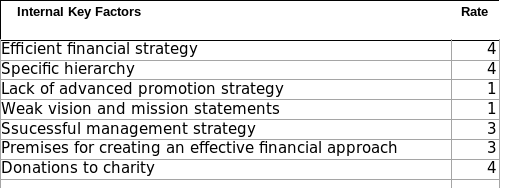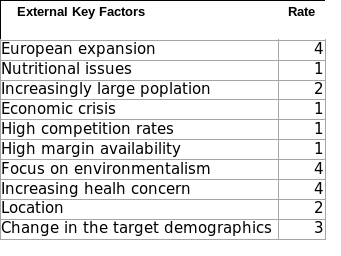Introduction and Overview
The Whole Foods, Inc. is an organization that provides services in the food industry and is currently looking for an option for expansion into the global market. Founded in 1980, the company has been using innovative concepts and approaches as the foundation for its operations ever since. In the current development of global economy and the emergence of a range of opportunities for entering the global market, Whole Foods will need a specific strategy for maintaining its net revenue high when becoming a part of the worldwide trade.
Mission, Goals and Current Strategies
At present, the company must obviously be targeted at expanding into the global market and designing an approach for retaining its competitiveness in the realm of high rivalry rates. There is no secret that food industry is dominated by several key corporations, which may pose a consistent and quite tangible threat to an organization that is comparatively new to the global market environment. Hence, it is most reasonable for Whole Foods to focus on the promotion strategies in order to uphold its high standards and attract as many customers as possible.
Internal Analysis
Management
- The leaders of the company have designed a set of unique principles, in accordance with which the company is run. One of the key attributes of the company, which distinguish it among a number of other corporations, the role of a store team leader must be named.
- Promoting a sense of purpose among the staff and creating a customer-focused environment is the key goal of the company managers.
Finance
- As far as the financial issues within the company are concerned, the company’s approach towards retaining its financial assets during the economic recession of 2008 deserves to be mentioned.
- Comparatively high prices are compensated with the accessibility of the so-called private-label products.
- Whole Foods also makes donations to charity organizations.
Marketing and service
- Though Whole Foods’ leaders are clearly aimed at becoming a part of the global food industry, the promotion campaign of the company has not been designed yet and seems the weakest spot of the organization at present.
- In order to create an efficient promotion campaign, Whole Foods will have to redefine its current approach towards marketing and incorporate both new and traditional media in order to advertise its services to the target audience.
Production and operations
- The company offers organic food and beverages as a commodity for its clients.
- Most of the company’s operations are carried out in the urban area; however, the focus on the local communities makes the company’s strategy too narrow to be adopted in the global economy without any changes made to the scope of these operations.
Human resource management
- The team-based approach allows Whole Foods to create the environment, in which professional growth of the employees can be facilitated and in which the information management strategy is based on the principle of sharing knowledge.
- The relationships between the members of the company are based on a specific hierarchy.
- Independency in communication and decision making is encouraged among the staff; thus, the concept of responsibility is planted into the working environment.
Research and development
- Whole Foods seems to pay comparatively little attention to R&D.
- It can be assumed that cutting costs of certain processes, such as transportation, will help update the R&D process within the company.
Other relevant internal factors
- Customer satisfaction is the primary goal of Whole Foods.
- Delighting customers in every interaction is the motto of the company.
External Analysis
Economic
- There is no need to stress the fact that competition within the global food market defines the course of the company’s policies to an impressive degree. While whole Foods does offer a unique product, the idea of providing customers with organic food is far from being a novelty, and the market is already saturated with the organizations offering similar services.
- High margin availability on organic products in the contemporary market predisposes a certain strain in the position of Whole Foods in the global economy.
Social and cultural
- According to the official statement of the company’s mission and vision, the corporate philosophy of the Whole Foods Organization revolves around the concept of sustainability. This is a very important characteristics of the company, which is going to be of great use once the firm enters the globalized economic environment; in order words, the sustainable principle of company’s processes management is a crucial advantage of Whole Foods, which is to be used as the company’s key asset.
- Another essential sociocultural aspect of Whole Foods’ operations, the Green movement needs to be mentioned. Though the environmental hysteria seems to have ended by the time that Whole Foods decided to enter the global market, the company’s policy based on the principles of sustainable use of natural resources, as well as the policy aimed at reducing the pollution rates, is quite welcome in the present-day setting.
Demographic
- Whole Foods addresses the needs of its customers in an appropriate manner, making it obvious that the employees adopt a customer-focused service strategy.
- It should also be born in mind that, with the change in the economic environment, an immediate alteration of the target audience is going to occur.
- The number of people, which the company identifies as its target customers, will also increase. As a result, it will be necessary to make alterations to the production process to deliver services to a greater amount of people within a comparatively short amount of time.
Other relevant external factors
- The location of the company’s headquarters in Los Angeles may be viewed as taking excessive costs; a less expensive venue for setting the headquarters could be used.
Conclusion
Though the process of entering the global market entails a number of issues to handle, particularly, the necessity to reconsider the current financial strategy, as well as the need to conjure a viable promotion campaign and come up with a proper approach towards the financial operations, particularly, the company’ key liabilities, the entrance to the global economy is the head start that will propel the Whole Foods
Company into the economic prosperity and open a plethora of opportunities for further progress. Once the Whole Foods organization gets its priorities straight and recognizes the need to address the demands of a wider range of audience, therefore, making its products more diverse, it will overcome the key barriers to entrance and be able to run business in the new economic environment successfully.
Depending on the perspective, global market can be viewed both as a pool of new and exciting opportunities and as a realm filled with threats and rivalry. What Whole Foods needs now is locating a golden mean between the two manners of viewing the global market and paving the way to its future success by using the emerging chances and avoiding major threats.
Appendix

